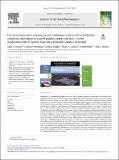| dc.contributor.author | O'Neill, Emer | |
| dc.contributor.author | Fehrenbach, Gustavo | |
| dc.contributor.author | Murphy, Emma | |
| dc.contributor.author | Alencar, Sérgio | |
| dc.contributor.author | Pogue, Robert | |
| dc.contributor.author | Rowan, Neil J. | |
| dc.date.accessioned | 2022-09-07T14:00:48Z | |
| dc.date.available | 2022-09-07T14:00:48Z | |
| dc.date.copyright | 2022 | |
| dc.date.issued | 2022-08-30 | |
| dc.identifier.citation | O'Neill, E., Fehrenbach, G., Murphy, E., Alencar, S., Pogue, R., Rowan, N.J. (2022). Use of next generation sequencing and bioinformatics for profiling freshwater eukaryotic microalgae in a novel peatland integrated multi-trophic aqualculture (IMTA) system: case study from the Republic of Ireland. Science of the Total Enviroment. 851: 158392. doi.org/10.1016/j.scitotenv.2022.158392 | en_US |
| dc.identifier.issn | 0048-9697 | |
| dc.identifier.uri | http://research.thea.ie/handle/20.500.12065/4028 | |
| dc.description.abstract | Development of integrated multi-trophic aquaculture (IMTA) systems constitutes a step change in the sustainable production of freshwater fish to meet emerging needs for high-protein foods globally. Recently, there has been a paradigm shift away from harvesting peat as a fuel towards the development of wettable peatland innovation (termed ‘paludiculture’), such as aquaculture. Such eco-innovations support carbon sequestration and align with a balanced environmental approach to protecting biodiversity. This novel peatland-based IMTA process in the Irish midlands relies upon natural microalgae for waste treatment, recirculation and water quality where there is no use of pesticides or antibiotics. This novel IMTA system is powered with a wind turbine and the process has ‘organic status’; moreover, it does not discharge aquaculture effluent to receiving water. However, there is a significant lack of understanding as to diversity of microalgae in this ‘paludiculture’-based IMTA processes. This constitutes the first case study to use conventional microscopy combined with next-generation sequencing and bioinformatics to profile microalgae occurring in this novel IMTA system from pooled samples over a 12 month period in 2020. Conventional microscopy combined with classic identification revealed twenty genera of algae; with Chlorophyta and Charophyta being the most common present. However, algal DNA isolation, 16 s sequencing and bioinformatics revealed a combined total of 982 species from 341 genera across nine phyla from the same IMTA system, which emphasized a significant underestimation in the number and diversity of beneficial or potentially harmful algae in the IMTA-microbiome. These new methods also yield rich data that can be used by digital technologies to transform future monitoring and performance of the IMTA system for sustainability. The findings of this study align with many sustainability development goals of the United Nations including no poverty, zero hunger, good health and well-being, responsible consumption and production, climate change, and life below water. | en_US |
| dc.format | PDF | en_US |
| dc.language.iso | eng | en_US |
| dc.publisher | Elsevier | en_US |
| dc.relation.ispartof | Science of the Total Environment | en_US |
| dc.rights | Attribution-NonCommercial-NoDerivatives 4.0 International | * |
| dc.rights.uri | http://creativecommons.org/licenses/by-nc-nd/4.0/ | * |
| dc.subject | Algae | en_US |
| dc.subject | Aqualculture | en_US |
| dc.subject | Food security | en_US |
| dc.subject | Ecosystem | en_US |
| dc.subject | Sustainability | en_US |
| dc.subject | Next generation security | en_US |
| dc.title | Use of next generation sequencing and bioinformatics for profiling freshwater eukaryotic microalgae in a novel peatland integrated multi-trophic aqualculture (IMTA) system: case study from the Republic of Ireland. | en_US |
| dc.type | info:eu-repo/semantics/article | en_US |
| dc.contributor.affiliation | Technological University of the Shannon Midlands Midwest | en_US |
| dc.contributor.sponsor | Interreg Atlantic Area Neptunus (Project EAPA_576/2018), Regional University Network European University (RUN-EU Project), and Bord Iascaigh Mhara (Project 2019 BIM-KGS-008) | en_US |
| dc.description.peerreview | yes | en_US |
| dc.identifier.doi | 10.1016/j.scitotenv.2022.158392 | en_US |
| dc.identifier.orcid | https://orcid.org/0000-0003-1344-6354 | en_US |
| dc.identifier.orcid | https://orcid.org/0000-0002-9389-3391 | en_US |
| dc.identifier.orcid | https://orcid.org/0000-0002-5620-0058 | en_US |
| dc.identifier.orcid | https://orcid.org/0000-0003-1228-3733 | en_US |
| dc.rights.accessrights | info:eu-repo/semantics/openAccess | en_US |
| dc.subject.department | Bioscience Research Institute TUS:MM | en_US |
| dc.type.version | info:eu-repo/semantics/publishedVersion | en_US |


